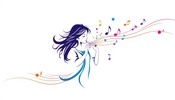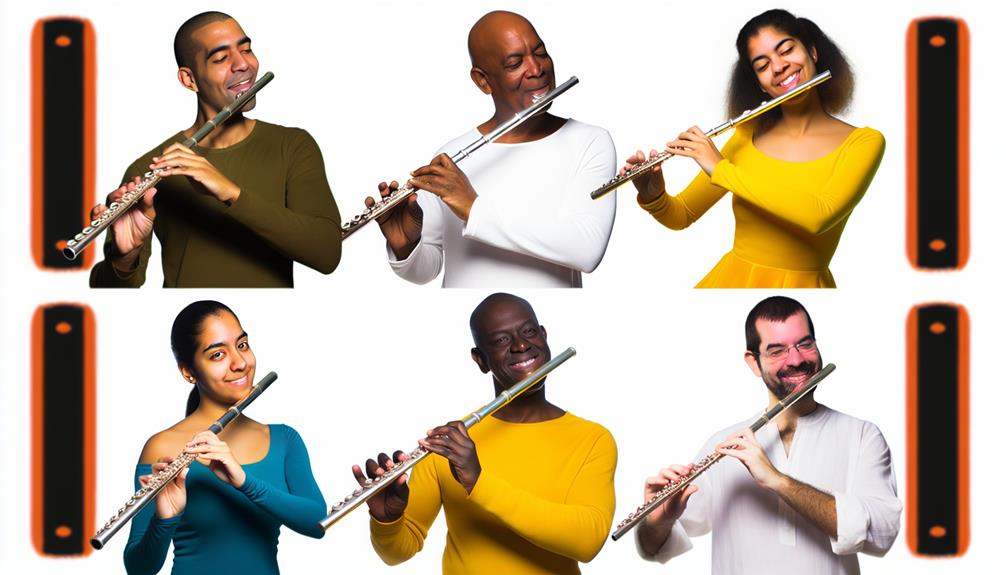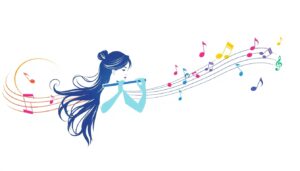Enhancing one's sight-reading skills on the flute is a fundamental aspect of becoming a proficient musician. By focusing on foundational elements such as note recognition, rhythm comprehension, and technical agility, flutists can develop a keen ability to interpret music on the spot. However, there is more to this skill than meets the eye. Stay tuned for valuable insights on how to approach and refine your sight-reading capabilities, taking your flute playing to new heights of musicality and expertise.
Key Takeaways
- Start with simple music pieces to build a strong foundation for sight-reading proficiency.
- Practice scales, arpeggios, and rhythmic patterns to enhance finger placement and tempo control.
- Utilize sight-reading apps and online resources for interactive exercises and real-time feedback.
- Divide challenging passages into smaller sections for focused practice on technique and expression.
- Seek regular feedback from teachers, ensembles, and online platforms to improve sight-reading skills consistently.
Importance of Sight-Reading Skills
Developing strong sight-reading skills is essential for flute players looking to expand their musical repertoire and enhance their overall musicianship. Sight-reading allows musicians to play music they have never seen before accurately and expressively. By honing this skill, flute players can experience increased confidence in their abilities and musical expression.
Increased confidence is a natural byproduct of proficient sight-reading. As flutists become more comfortable reading and playing music in real-time, their self-assurance grows. This newfound confidence extends beyond just sight-reading sessions; it seeps into all aspects of their flute playing. When musicians trust their sight-reading abilities, they are more willing to take on challenging pieces and explore new musical genres. This willingness to push boundaries and step out of their comfort zone can lead to significant growth as musicians.
Furthermore, sight-reading is a gateway to enhanced musical expression. When flute players can effortlessly navigate through a piece of music without stumbling over notes or rhythms, they can focus more on interpreting the music and infusing it with emotion. This ability to express themselves musically through sight-reading not only enriches their playing but also allows them to connect more deeply with the music and their audience. Ultimately, developing strong sight-reading skills is not just about reading notes on a page; it is about unlocking a world of musical possibilities and personal growth.
Start With Simple Music Pieces
To enhance sight-reading skills on the flute, a beneficial starting point is to tackle simple music pieces that provide a solid foundation for building proficiency and confidence in reading musical notation. Beginning with straightforward compositions allows for a gradual progression in music difficulty, ensuring that the player can comfortably grasp the basics before moving on to more complex pieces. By starting with manageable tunes, flutists can focus on developing crucial skills such as visual memorization of notes and rhythms, as well as finger placement on the flute.
Simple music pieces offer an excellent opportunity to understand fundamental music theory concepts, such as note values, time signatures, and key signatures, in a less overwhelming setting. This approach aids in the internalization of these principles, making it easier to navigate through more intricate compositions in the future. Moreover, practicing with simpler pieces enables players to familiarize themselves with common patterns and motifs found in music, enhancing their overall comprehension and fluency in sight-reading.
Practice Scales and Arpeggios
Enhance your flute playing skills by incorporating consistent practice of scales and arpeggios into your daily routine. Mastering scales and arpeggios is fundamental for any musician aiming to improve their sight-reading abilities. Here are some essential tips to help you make the most out of your practice sessions:
- Finger Placement: Pay close attention to your finger placement when playing scales and arpeggios. Ensure that your fingers are positioned correctly on the keys to produce clear and accurate notes. Practicing proper finger placement will not only enhance your technique but also facilitate smoother transitions between notes.
- Breath Control: Focus on controlling your breath while playing scales and arpeggios. Maintain steady airflow to sustain each note and achieve consistent tone quality. By practicing breath control alongside scales and arpeggios, you will develop greater endurance and improve your overall sound production.
- Note Transitions: Work on seamless transitions between notes to enhance your fluency and musicality. Practice moving from one note to the next smoothly and without interruption. Pay attention to the connections between different notes to create a cohesive and expressive musical line.
- Dynamics: Experiment with different dynamics while practicing scales and arpeggios to add depth and emotion to your playing. Explore variations in volume and intensity to bring life to the music and develop a more nuanced interpretation. Mastering dynamics will not only enrich your sight-reading skills but also elevate your overall musical performance.
Focus on Rhythm and Tempo
An integral aspect of refining your flute playing skills involves honing your sense of rhythm and maintaining a consistent tempo. Mastering rhythm not only improves your sight-reading but also enhances your overall musicality. Dynamic phrasing and expressive interpretation bring life to the notes on the page, allowing you to convey emotions and tell a story through your music.
To excel in rhythm and tempo, practice with a metronome to develop a strong internal pulse. Start slow, focusing on accuracy, then gradually increase the tempo as you become more comfortable. Incorporate various time signatures and rhythmic patterns into your practice routine to broaden your skills.
Here is a table to help you understand the importance of rhythm and tempo in flute playing:
| Rhythm and Tempo | Importance |
|---|---|
| Consistent Beat | Sets the foundation for musical expression and ensures coherence in music |
| Variety in Tempo | Adds interest and emotion to your playing, creating a dynamic performance |
| Accurate Timing | Allows for precise coordination with other musicians, enhancing ensemble playing |
Use a Metronome for Accuracy
Using a metronome is a fundamental tool for enhancing accuracy in your flute playing. A metronome provides a steady beat to follow, helping you stay in time and improving your overall precision. Here are four key benefits of using a metronome to enhance your sight-reading skills:
- Improves Concentration: The consistent clicks of a metronome help you concentrate on the music in front of you. By focusing on matching your playing to the metronome's beat, you develop a heightened sense of concentration, which is essential for accurate sight-reading.
- Enhances Precision: Playing with a metronome forces you to play each note at the exact moment it should be played. This precision is crucial for sight-reading, as it trains you to hit the right notes at the right time, ultimately improving your overall accuracy.
- Builds Internal Pulse: Over time, practicing with a metronome helps you develop a strong internal sense of pulse. This internal pulse will guide your playing even when you are not using a metronome, leading to more consistent and accurate performances.
- Develops Timing Skills: By practicing with a metronome regularly, you improve your timing skills. This is especially beneficial for sight-reading, as you learn to anticipate the rhythm of the music and play more confidently and accurately.
Incorporating a metronome into your practice routine can significantly enhance your sight-reading abilities by improving concentration and enhancing precision.
Learn to Scan Ahead
Developing the ability to scan ahead while sight-reading on the flute is a crucial skill that can greatly improve your performance accuracy and overall musical fluency. To enhance this skill, it is essential to employ effective reading strategies and mental preparation. When you scan ahead, your eye movements become more fluid and intentional, allowing for quicker note recognition.
Reading strategies play a significant role in mastering the art of scanning ahead. As you practice sight-reading, focus on looking slightly ahead of the note you are playing. Train your eyes to anticipate upcoming notes, rhythms, and musical patterns. By doing so, you will develop a proactive approach to reading music, enabling smoother transitions between notes and phrases.
Mental preparation is key to successful scanning ahead. Before starting a piece, take a moment to mentally map out the structure, key signatures, and any challenging passages. Visualizing the music in your mind before playing can help you stay one step ahead while reading. Cultivate a mindset that is alert and engaged, ready to tackle any musical surprises that may come your way.
Embrace Challenging Musical Passages
How can flutists effectively approach and conquer challenging musical passages to elevate their playing to new heights of skill and artistry? Embracing challenging musical passages is a crucial step in pushing boundaries and overcoming obstacles in your sight-reading journey. Here are some strategies to help you tackle these passages with confidence and finesse:
- Break It Down: Divide the challenging passage into smaller sections and practice each part slowly and methodically. Focus on mastering one section at a time before moving on to the next.
- Use a Metronome: Set a slow tempo on your metronome and gradually increase the speed as you become more comfortable with the passage. This will help you build accuracy and control.
- Focus on Technique: Pay attention to your fingerings, breath control, and articulation. Ensuring that your technique is solid will make it easier to navigate through complex passages.
- Practice with Dynamics and Expression: Don't just play the notes; infuse the passage with musicality by experimenting with different dynamics, phrasing, and interpretations. This will not only enhance your sight-reading skills but also elevate the overall musicality of your performance.
Utilize Sight-Reading Apps and Tools
Utilizing sight-reading apps and tools can significantly enhance a flutist's ability to practice and improve their sight-reading skills with efficiency and precision. These tools offer a wide range of interactive exercises that cater to different levels of expertise, making them ideal for both beginners and advanced players. By engaging with these apps, flutists can benefit from structured practice sessions that focus on areas where they need improvement, ultimately leading to a more well-rounded skill set.
One of the key advantages of sight-reading apps is the incorporation of visual aids that help players better understand musical notation and rhythm. These visual cues can aid in the quick recognition of notes and patterns, training the eyes to move smoothly across the sheet music. Additionally, the instant feedback provided by these tools allows flutists to track their progress and make adjustments in real-time, fostering a sense of accomplishment and motivation.
Moreover, the abundance of online resources means that flutists have access to a wealth of practice material at their fingertips. Whether it's through simulated practice sessions or virtual music libraries, these apps and tools offer a convenient way to hone sight-reading skills anytime, anywhere. By integrating these technological resources into their practice routine, flutists can take significant strides towards becoming more confident and proficient sight-readers.
Seek Feedback and Practice Regularly
To progress in sight-reading proficiency on the flute, actively seeking feedback and consistently practicing are essential components for honing this skill. Engaging in regular practice sessions and receiving constructive criticism can significantly elevate your abilities.
Here are four ways to effectively incorporate practice consistency and receive guidance:
- Establish a Routine: Dedicate a specific time each day to practice sight-reading. Consistency is key to improving your skills steadily over time. Setting aside as little as 15-20 minutes daily can yield remarkable results.
- Join a Music Group or Ensemble: Playing with others not only enhances your musicality but also provides valuable feedback. Being part of a group exposes you to a variety of music and challenges you to sight-read different pieces regularly.
- Work with a Music Teacher: A qualified music teacher can offer personalized guidance to address your specific sight-reading weaknesses. They can provide exercises tailored to your skill level and offer feedback on your progress.
- Utilize Online Resources: Explore online platforms that offer sight-reading exercises and opportunities for feedback. Websites and forums dedicated to music education can be valuable tools for honing your sight-reading skills.
Frequently Asked Questions
How Can I Overcome Performance Anxiety While Sight-Reading?
When facing performance anxiety while sight-reading, relaxation techniques can be invaluable. Incorporating deep breathing exercises, visualization techniques, and positive affirmations can help calm nerves and foster a sense of confidence.
Is It Better to Practice Sight-Reading Alone or With Others?
When considering sight-reading practice, the decision between solo and group settings hinges on personal preferences and goals. Solo practice offers individual focus and self-paced learning, aiding in mastering technical aspects.
On the other hand, group dynamics can foster competitive motivation and collaborative learning, enhancing overall musicianship. Both approaches have merits, so a balanced mix can be beneficial for honing sight-reading skills effectively.
What Should I Do if I Make a Mistake While Sight-Reading?
Error recovery is a crucial skill in sight-reading. When a mistake occurs, maintain confidence and continue playing. Shift your mindset from dwelling on the error to focusing on the upcoming notes. Stay present and keep a steady tempo.
Embrace mistakes as learning opportunities rather than failures. By cultivating a resilient approach to error recovery, you can enhance your sight-reading skills and build greater musical fluency.
Can Sight-Reading Skills Improve My Overall Flute Playing Technique?
Sight-reading skills have a profound impact on flute mastery by enhancing overall technique improvement.
The synergy between sight reading and flute playing is undeniable, as sight reading progress can lead to increased fluency, accuracy, and musicality.
Developing strong sight-reading abilities can elevate your playing to new heights, allowing for greater expressiveness and confidence in your performances.
Embrace the challenge of sight reading to unlock the full potential of your flute playing skills.
Are There Specific Exercises to Improve Sight-Reading in Different Key Signatures?
To enhance sight-reading skills in different key signatures, practicing scale variations is essential. This improves finger dexterity and familiarity with key changes.
Incorporating sight reading tips such as focusing on rhythm, intervals, and patterns can also be beneficial. Regular practice in diverse key signatures will gradually build confidence and proficiency in sight-reading, ultimately enhancing overall flute playing technique.
Stay committed and enjoy the journey of mastering this important skill!
Conclusion
In the pursuit of mastering sight-reading skills on the flute, one must navigate the intricate web of notes, rhythms, and tempo with precision and finesse.
Embracing challenges, practicing diligently, and seeking feedback are essential steps in this musical journey. Remember, the path to becoming a proficient sight-reader is paved with dedication and perseverance.
Keep pushing yourself to new heights, and soon you will be effortlessly gliding through even the most complex musical passages.



